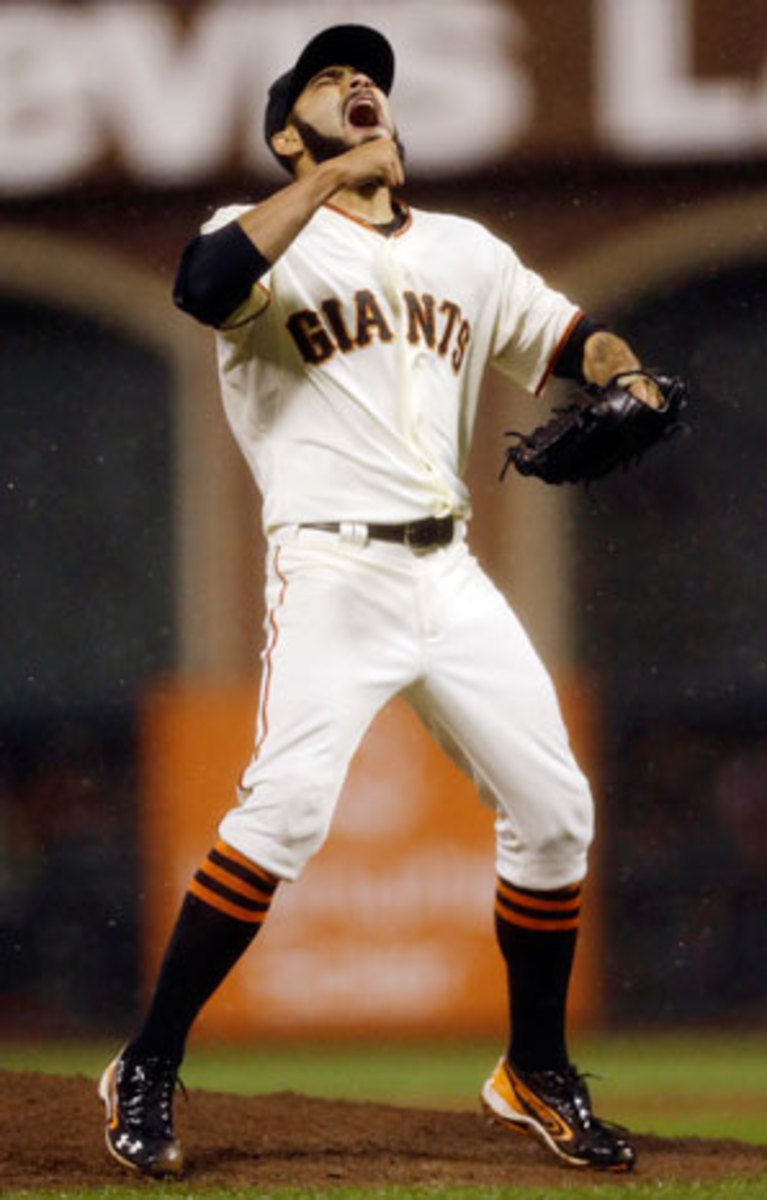Tigers and Giants could change template for how relievers are used
The importance of a closer, that mythic creature who works in the ninth inning with a one- to three-run lead, holder of a cushy gig that has been elevated to the level of fighter pilot times firefighter to the power of bounty hunter, has been drilled into us over the past two decades. You can't win without a veteran closer who knows how to get the last three outs!
Well, we now have a World Series between two teams who are putting the lie to that notion, at least at the moment. The Tigers famously got consecutive terrible outings from Jose Valverde, and have not allowed him to show his face since the second of those, 11 days ago in New York. The Giants, meanwhile, lost their closer, Brian Wilson, in the early days of the season to Tommy John surgery. You might not realize this, as Wilson's hirsute mug got as much camera time during the NLCS on Fox as the rest of the Giants' pitchers combined, but he can't and won't be pitching in the Series.
With Valverde's role still in question, the Tigers are likely to match up to get the last three outs of any game. In their final three wins over the Yankees, lefty Phil Coke got the last out each time. This was less because Coke has the scarlet C -- right-handed batters beat him like a drum, and he is one of the last men on the staff -- and more a function of the heavily lefthanded Yankee lineup and Joe Girardi's odd approach to deploying his personnel throughout the series.
Coke could well have an important role in the World Series, should Giants manager Bruce Bochy persist in lining up Brandon Belt, Gregor Blanco and Brandon Crawford in the sixth through eighth slots in the lineup. That lineup, with Buster Posey and Hunter Pence batting consecutively, also creates a great role for Octavio Dotel, who is back in the World Series a year after winning a ring with the Cardinals. Dotel is the reverse of Coke, a pitcher who is very effective against same-side hitters but gets knocked around when he doesn't have the platoon advantage. With the Yankees having just two righthanded hitting regulars, he had a limited role in the ALCS, but you could see Dotel called upon frequently to retire Bochy and Pence.
If Leyland would prefer to not match up, he has two pitchers with complete-inning experience and smaller platoon splits in Joaquin Benoit and Al Alburquerque. Benoit was presumed to be the closer in Valverde's exile, but he has not pitched since Game 1 of the ALCS. His home-run rate (14 in 71 innings) is scary, but partially the function of a fluky 18.2 percent HR/FB rate, and he has excellent strikeout and walk rates. Facing a team with less power and a home park less dangerous for flyball hitters makes Benoit the likely one-inning save choice. Alburquerque missed most of the season after elbow surgery (to repair a fracture, rather than Tommy John surgery), but in two seasons he's struck out nearly a third of the batters he's faced and has yet to allow a home run.
What's certain is that the Tigers enter the World Series without a closer. The one they had -- who was a marginal pitcher in the one-inning role for the past two years -- finally blew up, and they're now being forced to do what teams should do in the first place: pick the best pitcher for the situation based not just on inning and score, but on the skill sets of the pitchers and the hitters they will face.
That is what Bruce Bochy has been doing for two months. When Wilson went down in April, Bochy initially settled on Santiago Casilla as his closer. Casilla held the job until a stretch of poor outings in June and July cost him the role . . . mostly. Rather than switch to Sergio Romo or Jeremy Affeldt, Bochy, who you'll recall guided a deep bullpen to the World Series title in 2010, began using all of them. Not only did Bochy not funnel the saves to one man, he even began using multiple pitchers in the ninth inning as matchups warranted, sometimes even getting four- to six-out saves from his relievers.
Bochy wasn't completely getting back to the relief-ace model of the 1970s, but his usage of his top three relievers was as close to what statheads have been looking for as anything we've seen in a while. Bochy took the save statistic out of the equation in choosing his pitchers, and was rewarded with excellent performance and a fairly smooth trip to the NL West title.
Now, neither Jim Leyland nor Bruce Bochy planned it this way. Leyland had a closer two weeks ago, and Bochy went through two of them before getting to where he is today. However, this World Series, as it begins, is the first to feature two teams without save specialists in at least 20 years, dating to when the 1992 Toronto Blue Jays had two great one-inning relievers in Tom Henke and Duane Ward and the Atlanta Braves had a committee with Jeff Reardon at the head. You could argue it's the first since 1985, when the Royals' Dan Quisenberry was more an ace reliever and the Cardinals used an assortment of pitchers in the ninth inning. It makes for more entertaining baseball, as the late-inning maneuvers of the managers are less predictable.
Statheads have been arguing for years that the closer-centric bullpen model is not the optimal way to run a bullpen. Perhaps the 2012 World Series will make the case on the field in a way that all the studies and charts and tables never could.






